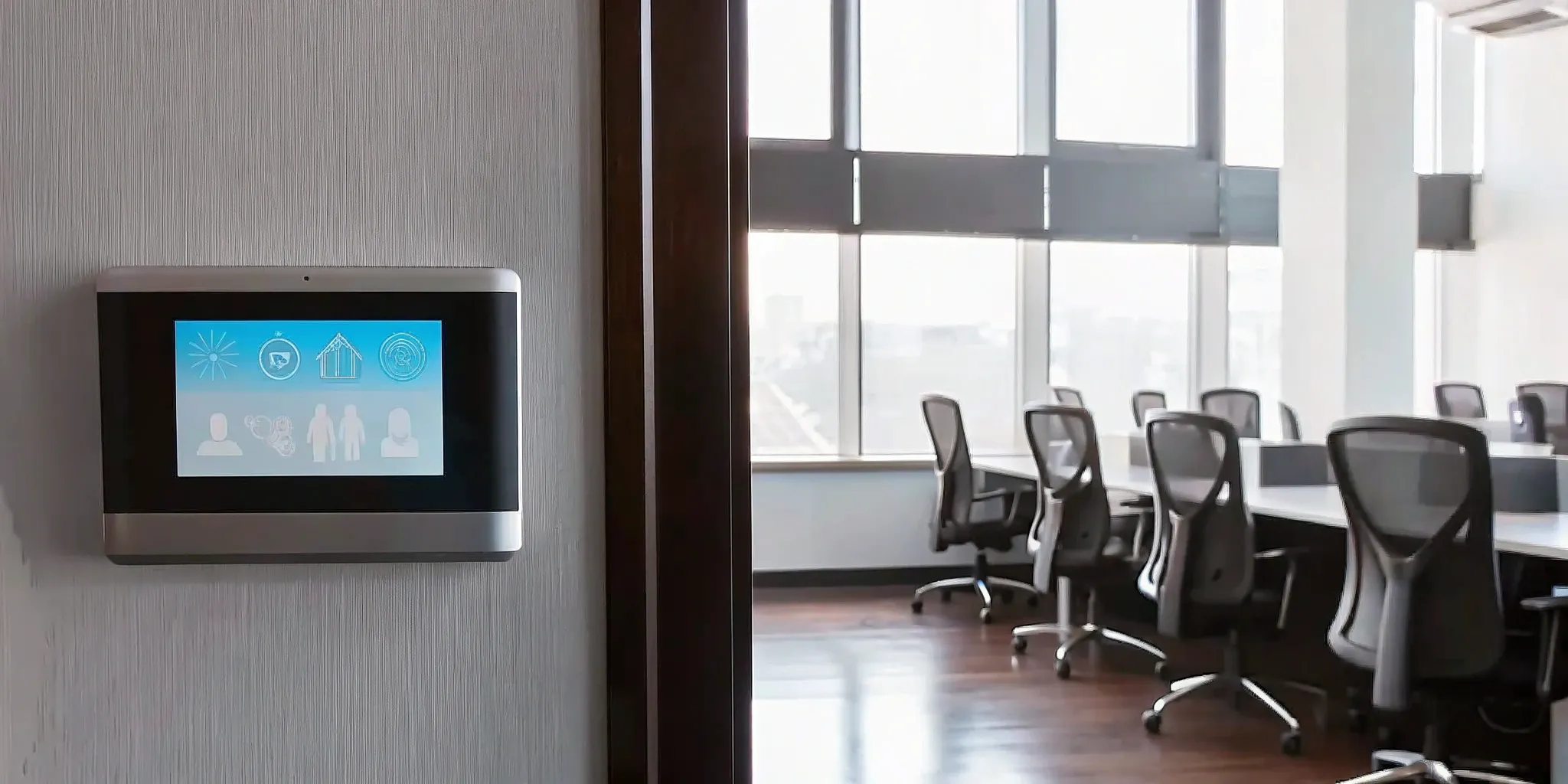The role of the physical office has changed for good. It’s no longer the default place for focused, individual work—that can happen anywhere. Instead, the office must become a destination for the things we can’t do as well alone: brainstorming, mentoring, and building real connections. When you treat office days as purposeful gatherings rather than mandatory attendance, the entire dynamic shifts. The key to improving return to office morale is to make the commute feel worth it. We’ll show you how to design an in-office experience that centers on career growth and meaningful collaboration, turning your workplace from a mandate into a magnet.
How to Actually Improve Return to Office Morale
Creating a positive and welcoming return-to-office experience requires understanding employee concerns and offering tailored solutions.
- Acknowledge mixed emotions about returning to the office and address individual concerns such as health, commuting, and childcare.
- Enhance office aesthetics with color, art, and comfort to create an inspiring workspace.
- Implement flexible work policies, such as hybrid models and flexible hours, to boost work-life balance.
- Foster a positive culture through team-building, open communication, and incentive programs to increase motivation and engagement.
Before we can fix the morale problem, it helps to understand why so many companies are mandating a return to the office in the first place. While it might feel like a sudden reversal, the reasons are often complex, ranging from concerns about company culture to more practical, and sometimes unspoken, business objectives. For many leaders, the push is rooted in a belief that in-person interaction is essential for innovation, collaboration, and mentorship. They worry about a decline in spontaneous creativity—those "water cooler" moments that can spark new ideas. Others are concerned about maintaining a cohesive company culture and ensuring that new hires are properly integrated and mentored by senior staff. Understanding these motivations is the first step toward finding a middle ground that works for everyone.
The Push for Control and Trust
Let's be honest: a major driver behind many RTO mandates is a lack of trust. When teams are out of sight, some leaders worry they aren't being productive. This creates a disconnect, as 87% of hybrid employees report their productivity is the same or better, while 85% of leaders fear their teams aren't working hard enough. This isn't just about getting work done; it's about a perceived loss of control and visibility. As Curt Steinhorst noted in Forbes, "Forcing people back to the office because you don't trust them will likely make them less productive and unhappy." This approach can backfire, creating a culture of micromanagement rather than one built on mutual respect and a focus on results. True productivity comes from empowerment, not just presence.
A Quiet Way to Downsize
In some cases, a return-to-office mandate can serve as a form of "quiet downsizing." Instead of initiating layoffs, which can be costly and damage public perception, some companies implement strict RTO policies knowing that a portion of their workforce will choose to leave. As one manager on Reddit suggested, this strategy allows companies to reduce their staff without the negative press of official firings. Employees who value flexibility, have long commutes, or have built their lives around remote work may find the new requirements untenable and resign. While this might achieve the goal of trimming the workforce, it often comes at the cost of losing valuable, high-performing employees who simply can't or won't comply.
Fostering Mentorship and Training
One of the most valid arguments for returning to the office is the benefit of in-person mentorship and training. Junior employees, in particular, gain a lot from observing senior colleagues, asking spontaneous questions, and receiving immediate feedback. Working together in the same space creates natural learning opportunities that are harder to replicate remotely. Many leaders believe that this hands-on guidance is crucial for career development and for passing down institutional knowledge. The challenge is to create an office environment that intentionally fosters these connections, rather than simply assuming they'll happen just because people are in the same building. The goal should be to make office time purposeful for growth and collaboration.
The Real Cost of RTO Mandates
While companies have their reasons for wanting employees back in the office, strict mandates come with significant costs that can affect the entire organization. The most immediate impact is often on employee morale, but the ripple effects can touch everything from retention and recruitment to overall well-being. Forcing a transition that employees don't want or aren't ready for can breed resentment and disengagement, undoing years of work building a positive company culture. The financial and cultural price of a poorly executed RTO plan can be steep, leading to a cycle of attrition and a struggle to attract top talent in a competitive market. It's a delicate balance, and ignoring the human side of the equation is a recipe for long-term problems.
Declining Morale and Well-Being
When employees feel their flexibility and autonomy are being taken away, their morale and well-being often take a hit. The return of long commutes, the cost of transportation and lunches, and the challenge of juggling personal responsibilities can lead to increased stress and burnout. For example, an internal survey at JPMorgan revealed that since the RTO mandate began, employees felt their work-life balance and overall health had worsened. This decline in well-being isn't just a personal issue for employees; it directly impacts their engagement, creativity, and productivity at work. A happy, healthy team is a productive team, and ignoring their concerns can create a negative atmosphere that permeates the entire office.
The Risk of Losing Top Talent
In today's job market, flexibility is no longer a perk—it's an expectation. A staggering 56% of employees would rather quit or look for a new job than return to the office full-time. This means that rigid RTO mandates put companies at serious risk of losing their most valuable and experienced employees. Top performers often have many options, and they will gravitate toward organizations that trust them and respect their need for work-life balance. The cost of replacing a skilled employee—including recruitment, hiring, and training—is substantial. Forcing everyone back to their desks without considering individual needs is a gamble that can lead to a significant brain drain, leaving you with a less experienced and potentially less motivated team.
Unique Challenges for New Hires
While in-person work can benefit new hires, a forced return can also present unique challenges for them. Many early-career professionals began their careers remotely and have never experienced traditional office life. They may be unfamiliar with the unspoken rules of office etiquette, from how to join a conversation to the appropriate level of workplace chatter. Simply bringing them into the office without proper guidance can be overwhelming and counterproductive. These employees need structured support and clear communication to help them adapt. Without it, they may feel isolated or anxious, which can hinder their ability to integrate into the team and perform at their best. A thoughtful onboarding process is key to their success in a hybrid environment.
The Great Disconnect: Leaders vs. Employees
One of the biggest hurdles in the return-to-office debate is the gap in perception between leadership and employees. While leaders are focused on big-picture concerns like culture, innovation, and productivity metrics, employees are dealing with the day-to-day realities of commutes, work-life balance, and personal well-being. This disconnect often leads to policies that feel out of touch with what employees actually need to thrive. Leaders see an empty office and worry about lost productivity, while employees working from home feel more focused and efficient than ever. Bridging this gap requires open communication and a willingness from both sides to understand the other's perspective. Without that shared understanding, RTO policies will continue to feel like a top-down mandate rather than a collaborative strategy.
Conflicting Views on Productivity
The debate over productivity is at the heart of the leader-employee disconnect. As mentioned earlier, data from Forbes highlights a stark contrast: 87% of employees feel they are just as productive, if not more so, when working in a hybrid model, yet 85% of leaders are concerned that their teams are not working hard enough. This discrepancy shows that leaders and employees are measuring productivity differently. Leaders may be looking at traditional metrics like office attendance, while employees are focused on their actual output and the tasks they complete. This difference in perspective can lead to a breakdown in trust, with leaders feeling the need to monitor their teams and employees feeling undervalued and micromanaged.
The Desire for a Voice in the Decision
Employees don't just want flexibility; they want to be part of the conversation. Research shows that 78% of employees want a say in their company's flexible work policies, but only 31% feel like their company has actually asked for their input. This lack of consultation can make employees feel powerless and disrespected, as if their opinions and needs don't matter. When decisions are made behind closed doors and then handed down as mandates, it creates an environment of resentment. Involving employees in the decision-making process, even through simple surveys or feedback sessions, can make a world of difference. It shows that you value their perspective and are committed to creating a policy that works for everyone.
Specific Strategies to Improve RTO Morale
Improving morale during the transition back to the office isn't about grand, expensive gestures. It's about being thoughtful, flexible, and communicative. The goal is to shift the narrative from a mandatory return to a purposeful gathering, where time in the office is valued for collaboration, connection, and growth. This requires a multi-faceted approach that addresses employee concerns head-on while reinforcing the benefits of in-person interaction. By focusing on practical support, clear communication, and a culture of trust, you can create a positive and productive environment that embraces the best of both remote and in-office work. It's about making the office a place people *want* to be, not just where they *have* to be.
Focus on Career Growth
One of the most effective ways to make the office appealing is to position it as a hub for career development. A Slack report found that 63% of people who quit a job cited a lack of advancement opportunities as a key reason. Use in-office days for activities that directly contribute to growth, such as mentorship programs, hands-on training sessions, and cross-departmental projects. When employees see a clear link between coming into the office and advancing their careers, they are far more likely to view the commute as a worthwhile investment. This shifts the focus from simply being present to being there for a purpose that benefits them directly.
Ask for (and Act on) Feedback
If you want to know how to improve morale, ask your team. Use surveys, polls within your communication tools, or town hall meetings to gather honest feedback about the RTO experience. Ask what's working, what isn't, and what would make their time in the office more valuable. The most critical step, however, is to act on that feedback and communicate the changes you're making. When employees see that their opinions lead to real action, it builds trust and makes them feel like valued partners in the process. This continuous feedback loop is essential for refining your hybrid model and ensuring it meets the evolving needs of your team.
Offer Practical Support for the Transition
Acknowledge that returning to the office is a significant adjustment and offer practical support to make it easier. This could include subsidizing commuting costs, offering flexible start and end times to avoid rush hour, or providing on-site amenities like free coffee and snacks. It's also important to ease employees back into office life rather than demanding a full-time return overnight. Start with a few structured office days and use a hybrid work software to help teams coordinate their schedules. Tools like Officely, which integrate directly into Slack or Teams, make it simple for employees to see who will be in the office and book a desk near their colleagues, turning a potentially stressful process into a seamless one.
Making Office Days Count
To make the commute worthwhile, ensure that days spent in the office are focused on collaborative, high-value activities that can't be done as effectively at home. Avoid having employees come in just to sit on video calls all day. Instead, designate office days for team brainstorming sessions, project kick-offs, and client meetings. Encourage teams to coordinate their in-office schedules to maximize face-to-face interaction. Using a hot desk booking system allows employees to reserve spaces near their teammates, while a meeting room booking tool ensures they have the space they need to collaborate effectively. When office time is purposeful, it feels less like an obligation and more like an opportunity.
Lead with Transparency
Transparency is the foundation of trust. Be open and honest about the reasons behind your RTO policies. If the goal is to foster collaboration, explain how you plan to facilitate that. If you're concerned about mentorship, share the programs you're putting in place. Leaders who are transparent about their motivations and the challenges they're facing are more likely to get buy-in from their teams. This also means being open to adjusting the plan based on what's working and what isn't. A transparent approach shows respect for your employees and reinforces that you're all on the same team, working toward a common goal.
Measure Results, Not Presence
Ultimately, the most successful hybrid models shift the focus from "seat-time" to outcomes. Instead of tracking who is in the office and for how long, concentrate on what your team is achieving. Set clear goals and key performance indicators (KPIs), and give your employees the autonomy to decide where and when they work best to meet those goals. As Curt Steinhorst advises, leaders should focus on what people achieve rather than just their physical presence. This outcome-oriented approach builds a culture of trust and accountability, empowering employees to take ownership of their work and proving that great results can be delivered from anywhere.
Frequently Asked Questions
My team's morale has dropped since we announced our return-to-office plan. What's the most important first step to fix this? The best place to start is by opening a genuine dialogue. Before you can fix the problem, you need to understand it from their perspective. Instead of just announcing policies, ask for feedback through surveys or small group discussions. Acknowledge that the transition is a big deal and that their concerns about commuting, costs, and work-life balance are valid. Acting on even small pieces of feedback shows you're listening and builds back the trust that is essential for a positive workplace culture.
We want the office to be for collaboration, but people just come in and take video calls. How can we change that? This is a common problem that happens when office time lacks a clear purpose. The key is to be intentional about why people are coming in. Encourage teams to coordinate their schedules for specific collaborative tasks like project kick-offs, brainstorming sessions, or team-building activities. Using a simple desk booking tool can help everyone see who’s in on which days, making it easier to plan for that valuable face-to-face time and ensuring the commute is actually worth it.
How can we justify the return to the office when our team feels they're just as productive at home? This requires shifting the conversation from productivity to purpose. Instead of debating where people complete tasks faster, focus on the unique benefits of being together. Frame office days as opportunities for career growth, mentorship, and building stronger team connections—things that are harder to replicate remotely. When employees see that in-office time is directly linked to their own development and not just a mandate for presence, the justification becomes much clearer.
We're worried about junior employees missing out on mentorship. How can we make the office a better place for their growth? You can turn this concern into a major selling point for your office. Create structured opportunities that make mentorship a core part of the in-office experience. This could involve setting up formal mentorship pairings, hosting lunch-and-learns with senior leaders, or designing projects that require cross-functional collaboration. When junior staff know that coming in means direct access to guidance and learning, the office transforms from a requirement into a resource for their careers.
What's the best way to gather feedback about our RTO policy without it turning into a complaint session? To get constructive feedback, you need to ask constructive questions. Instead of open-ended questions like "What do you think of the RTO plan?", try more solution-oriented prompts. Ask things like, "What would make your in-office days more valuable?" or "What's one thing we could do to make the commute easier?" This frames the conversation around improvement rather than just problems and gives you actionable ideas you can implement to show your team they've been heard.
Key Takeaways
- Acknowledge the leader-employee disconnect: Successful return-to-office plans start by understanding the gap between leadership's concerns about culture and employees' need for trust and work-life balance. Your team's resistance isn't about avoiding work; it's about protecting their autonomy and well-being.
- Make the commute worth it with purposeful office days: Transform the office from a mandate into a destination for career growth, team collaboration, and mentorship. When in-person time is dedicated to activities that are genuinely better together, employees will see it as a valuable investment.
- Shift your focus from presence to performance: Build a culture of trust by asking for and acting on employee feedback, offering practical support for the transition, and measuring success by what your team achieves—not where they achieve it.






.webp)


.jpg)



.svg)